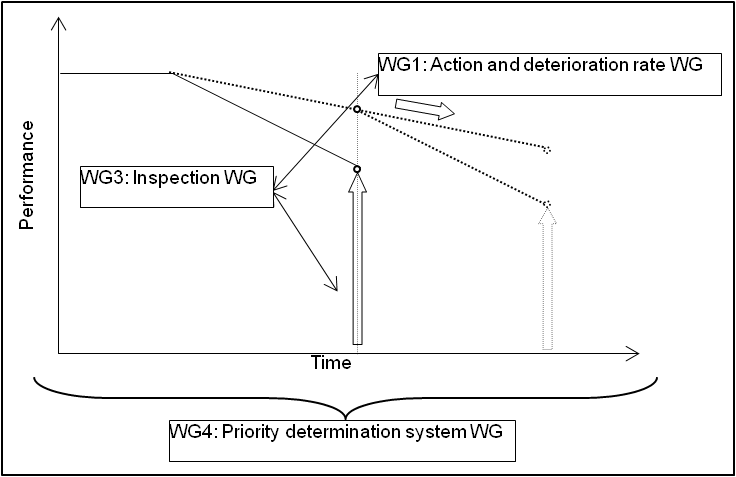1. Introduction
|
A large number of deteriorated concrete structures have to be maintained at present and in the near future in Japan. The economic and human resources condition are severe, while the overage structures have been accumulated up to now. Therefore, the effective inspection of structures, which is placed at the beginning of maintenance procedure, is pretty important for the reasonable maintenance. The strategy of the remedial measures, which can produce the highest effect for upgrading the performance of structures, must be also needed. For the reasonable maintenance and management, it has to be demonstrated which structures are to be maintained selectively and early, because the deterioration rate and degree vary according to the regional condition in environment. The deterioration rate and degree will differ in each member or a part of member, even in the same structure.
|
JSCE-342 subcommittee was organized in May 2010, in order to establish the scheme to determine the priority in maintenance and management of deteriorated concrete structures. The main activities of this subcommittee are as follows;
|
- Investigation on the technique to estimate the regional deterioration rate based on the geographical and environmental conditions of structures.
- Investigation on the technique to find the difference of deterioration rate in each member or a part of member, even in the same structure.
- Investigation on the technique to identify the member or a part of the member which causes the significant reduction in the structural performance.
- Investigation on the easy and quantitative inspection technique to find the member or a part of the member with the early deterioration rate or the significant effect on the structural performance.
- Arrangement of the practical problem on the determination of the priority in maintenance and management.
|
|
2. Activities in Working Groups
|
Figure 1 shows the factors to determine the priority in maintenance and management, and their relationship with the working groups. Performance over time should be considered in the performance based design and maintenance. So, the factors to determine the priority in maintenance and management can be divided into the following two aspects.
|
- Deterioration (performance degradation) rate caused by environmental action or material property
- Current or coming performance
|
Those two factors correspond to the degradation gradient and level of performance. In case of chloride ion attack environment, higher priority should be considered in structures, members or a part of members with higher air born chloride ion. Even if a structure consists of members with the similar degradation level, the priority of remedial measures will be higher in a member with the most significant effect on the structural performance among those members.
|
 |
| Fig.1 Factors to determine the priority and their relationship with working groups |
The inspection and monitoring are also important, since those are measures to ensure the performance over the required performance at any time of service life. The information derived from the inspection and monitoring will bring easier estimation of current performance in maintenance phase than in design phase.
|
From the above discussion, the following four working groups were arranged.
|
WG1: Approach based on action and deterioration rate
The objective of WG1 is to determine the priority in maintenance based on the action and deterioration rate. For this purpose, the factors in the environmental action and their interaction were defined in each deteriorating mechanism. The effect caused by environmental action was also investigated. On the other hand, the latest techniques on the quantitative analysis of the degree of environmental action and their evaluation results were introduced. Furthermore, the consideration of the spatial distribution in deterioration into the determination of the priority was discussed.
|
WG2: Approach based on evaluation of performance
WG2 dealt with the structural performance related to safety and serviceability of concrete structures. The grading method is often useful for qualitative evaluation of structural performance, while the numerical analysis may be used for the quantitative estimation. Consequently, the former will be available for preliminary decision of the remedial measures, and the latter for the reasonable decision and design of remedial measures. Moreover, the difference in the ideas on the practical use of the numerically structural analysis between the administrators of structures and the researchers was introduced.
|
WG3: Inspection technique on determination of priority
WG3 dealt with the inspection techniques used for the numerical evaluation of deterioration rate and performance, which was needed in WG1 and WG2. The grading techniques, which had been used in situ by the administrators of concrete structures, were summarized. Furthermore, the inspection techniques and maintenance procedure were discussed in the prestressed concrete structures, which had the high performance but the difficulty in the detection of deterioration.
|
WG4: Priority determination system
WG4 summarized the priority determination system, which had been used in situ by the administrators of concrete structures. Not only the problem or difference but also the common matters in the priority determination systems of some administrators’ organization were arranged. It is shown that ‘macro’ management system is popular in a large number of groups of structures up to now and ‘macro’ management often does not need the quantitative deterioration prediction and performance evaluation.
|
|
3. Concluding remarks
|
Table 1 summarizes the problems in the determination of the priority in maintenance and management of concrete structures.
|
| Table.1 Problems in the determination of the priority in maintenance and management |
 |
The transition period from ‘Corrective maintenance’ to ‘Preventive maintenance’ seemed to bring those problems. The above problems will be discussed continuously and the practical use of the determination system in priority will be performed in the coming second term of this subcommittee.
|